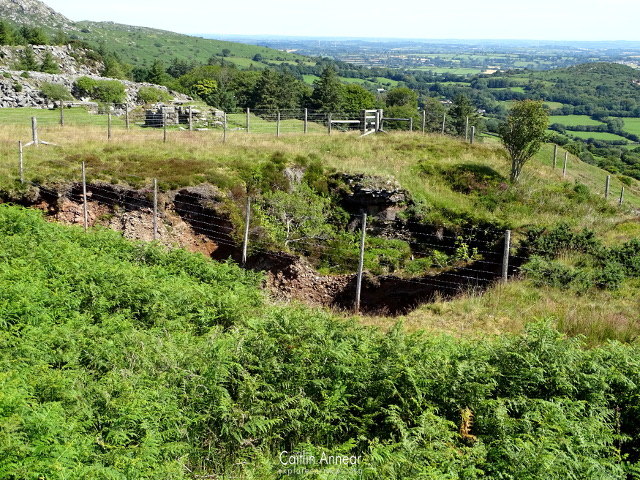Up on Stowe’s Hill north of Minions village are the scant remains of Stowe’s Mine. Little remains of this small workings except some huge craters and concrete machinery bases, but it’s definitely worth a visit.

The open crater of Jope’s/ Moon or New shaft
The first records of mining in this area were at ‘Stowe’s Ende’ where the old men followed a lode that ran up the hill. The area must have been mined prior to the 19th century as in 1824 it was combined with Wheal Jenkin and an engine was installed; this operation only operated on a loss and came to halt after just a year. In 1836 it was amalgamated into Cornwall Great United Mines under the name Wheal Julia, alongside Greenhills, Wheal Prosper and Wheal Jenkin with the intention to work them all as one tin mine. Like its predecessor the mine quickly accumulated debts and was forced to close.
From 1842 Stowe’s was worked as part of Wheal Phoenix, however this section once again failed to make profits and two years later was abandoned while the rest of the sett carried on. Little happened until 1870 when it was taken up by Phoenix United and for once it proved to be successful, however the cost of pumping the whole sett soon became expensive. A fire in the miners dry in 1888 sealed its fate as another costly venture and by the 1890’s, the mine was forced to close.

The final reworking occurred between 1907 and 1914 where the entire sett was retried again by Phoenix United. This included the installation of a new compressor engine at Stowe’s shaft. With the sinking of Prince of Wales shaft, the majority of the pumping was going to be done from here, however as sampling of the mine continued they discovered that the old men had been much more thorough stripping the mine of ore than thought. The mine closed for the final time.

Building outline next to Jope’s/New shaft
Stowe’s (80 fathoms/146m), Old Stowe’s, Jope/Moon’s/New Engine, Anna’s (112 fathoms/205m), Redburrow, Hard, Harriet’s, Mary’s and Tom’s.
Stowe’s, New, South and Snuff Box.

During its life Stowe’s didn’t use a lot of equipment, however it was the host to the only Newcomen engine in East Cornwall, erected in 1730. It also had a 22″ or 25″ rotative engine, an engine house in 1824 and a stamps engine in 1836. The last reworking saw the building of concrete mountings for a whim and the installation of a horizontal 120 HP compressor engine.
The whole mine site is free to access. The shafts on this section have not been capped but are fenced due to their instability.
There are two free car parks in Minions.
Acton, B. and Brown, K. (1999) Exploring Cornish Mines: Volume Four. Truro: Landfall Publications.
Gillard, B. (2004) ‘Cornwall Industrial Settlements Initiative MINIONS (Caradon/Liskeard)’. Available at: https://www.cornwall.gov.uk/media/28967111/minions.pdf (Accessed: 23 July 2020).
Sharpe, A. (1989) The Minions Survey Part 2. Truro. Available at: http://map.cornwall.gov.uk/reports_event_record/1989/1989R019.pdf.



Your account is excellent and I greatly enjoyed reading it having a very close interest in the ‘Phoenixes’.
It’s surprising how a later landmark can sideline an earlier one. Despite the fact “Stowe’s Cottages” are southeast of Cheesewring, Stowe’s Hill/Stowe’s Pound are north of Cheesewring, but once the quarry lopped out a great chunk of the south slope of the hill it rather split it in two. So Stowe Mine, taking the name of the hill, underline’s it as one of the earliest workings, later ‘Stowe’s Section’ of Phoenix United.
The shafts serving the West Section of Phoenix Utd workings (the main part of the mine being the east!), going west in order are Hamilton’s shaft above the road, Stowe’s and an adjacent shaft (possibly Red Burrow) (both now run-in at surface inside the fenced-off area), then New Engine shaft (possibly doubling as Anna’s), then Polkinghorne’s (though there’s an open air-shaft between Anna’s and Polkinghorne’s, which drops into the workings eventually becoming some very impressive stopes possibly 95m below surface). The last, Polkinghorne’s, is close to Withybrook Sett, which in turn borders West Phoenix sett, both the latter eventually being absorbed.
But would you mind much if I made a very very gentle comment: Where you say “…were worked by old men…”, they are traditionally referred to as “….THE old men…” to differentiate from any old man. We refer to “old men’s workings” but the people who worked them decades, or centuries, (or even millenia!) before are “THE old men”. A minor point, but traditional expressions can be lost over time – hope you won’t be offended.
Thanks, good spot! Re-reading that again it sounds like a group of octogenarians were up there digging around – all changed.